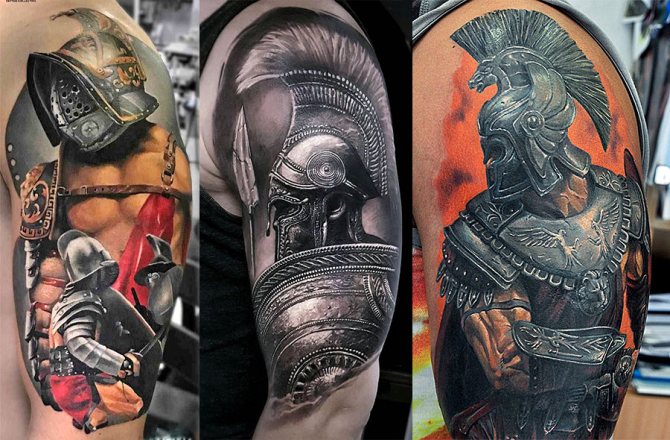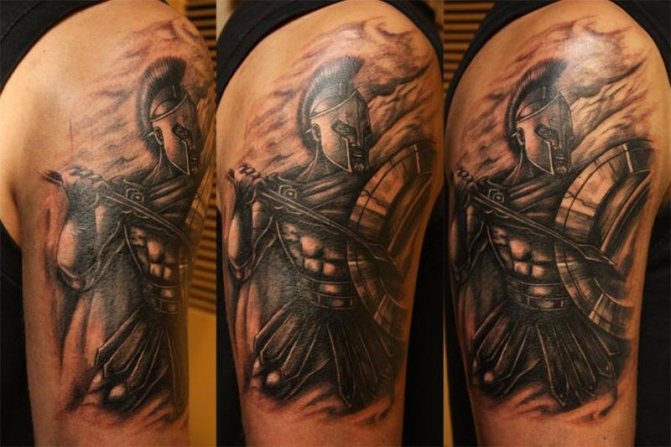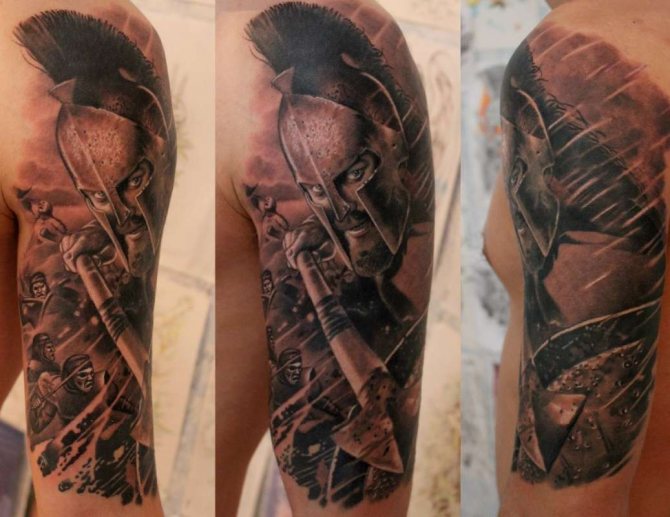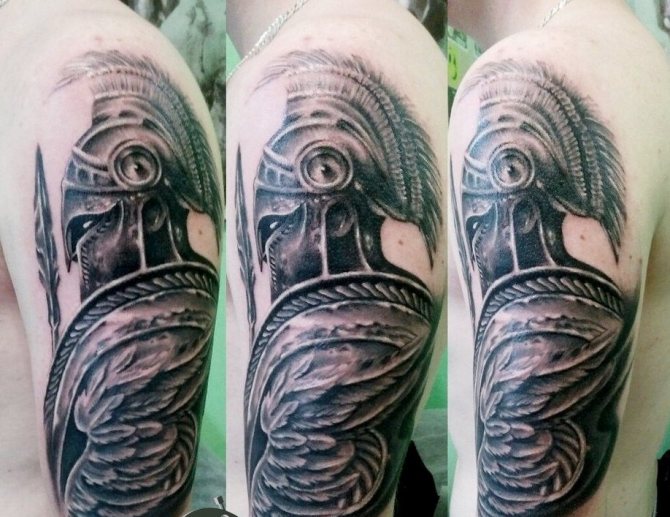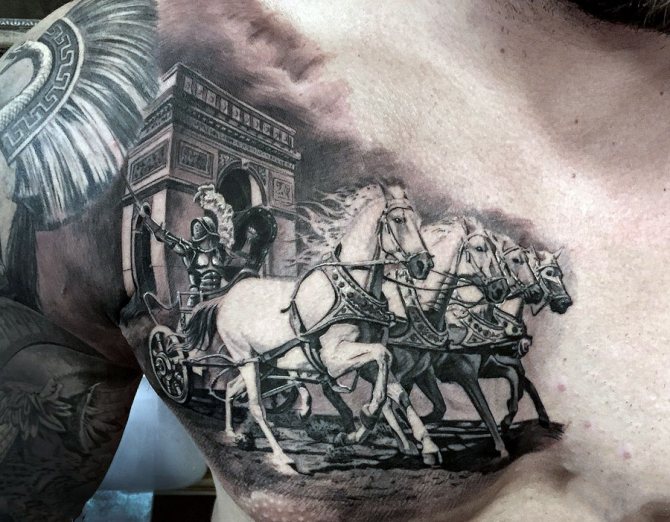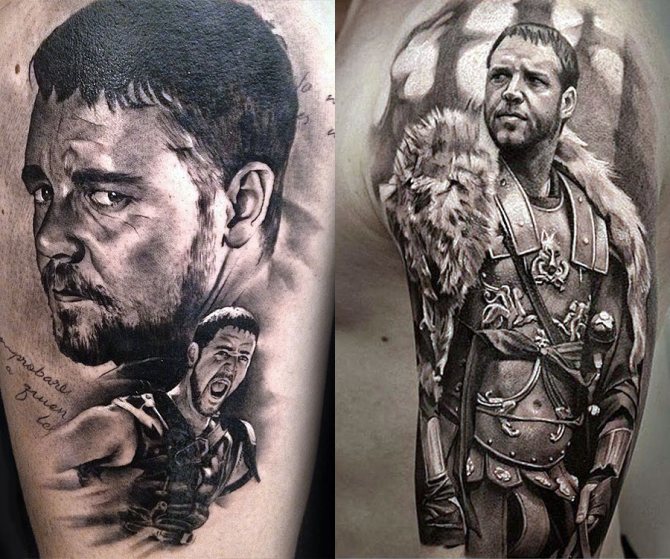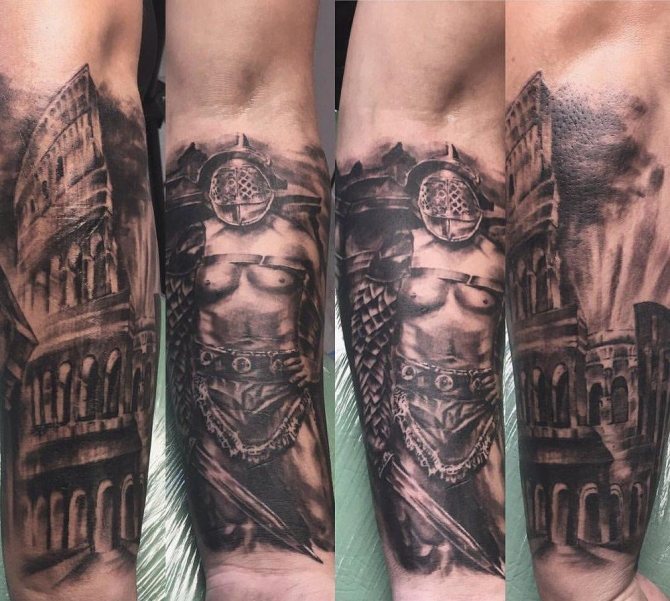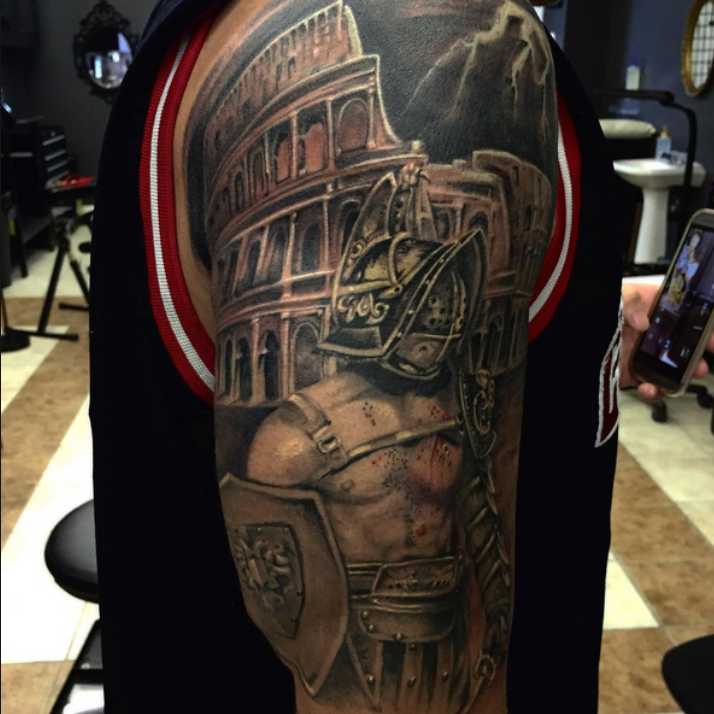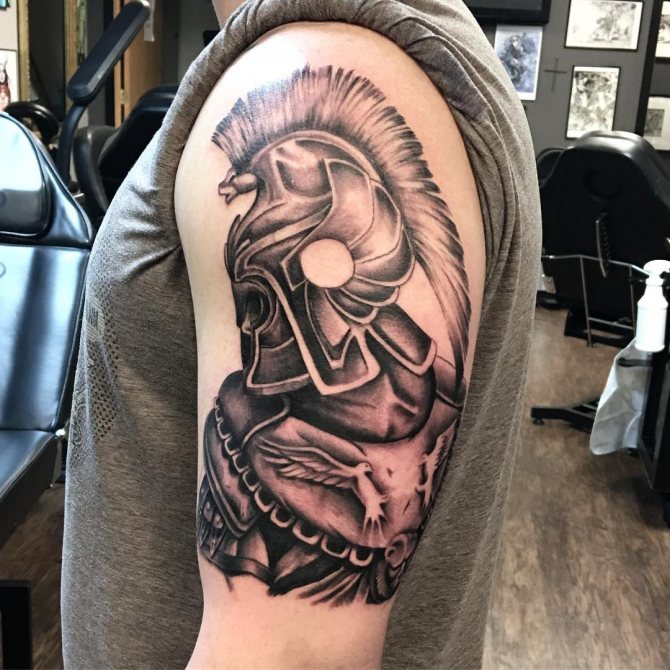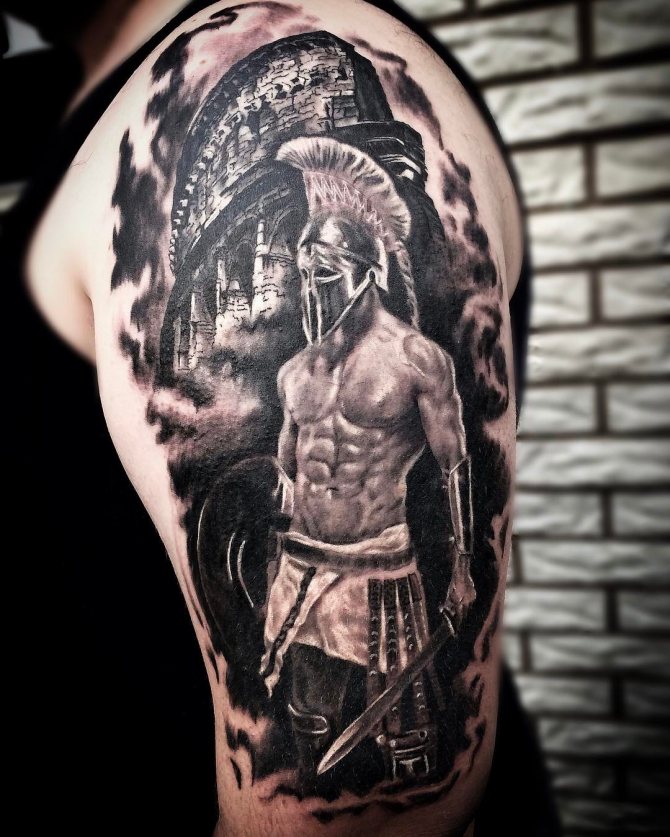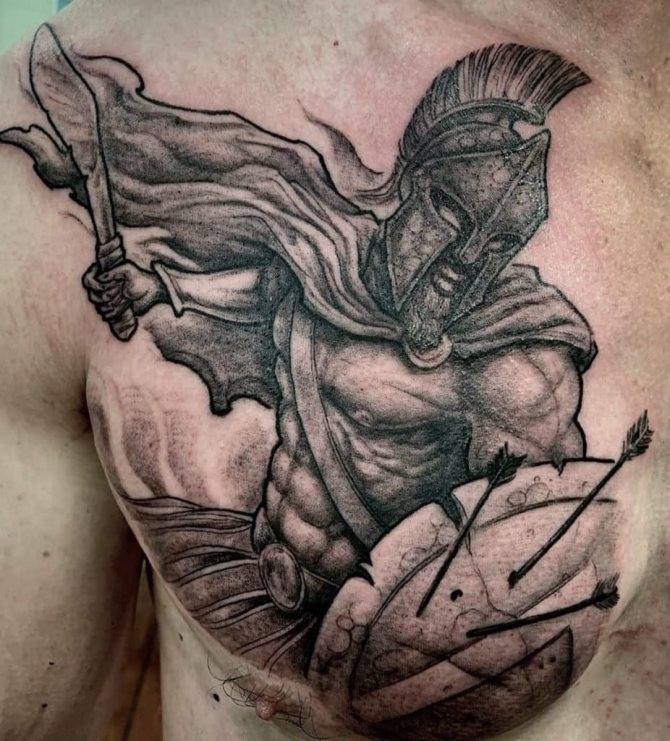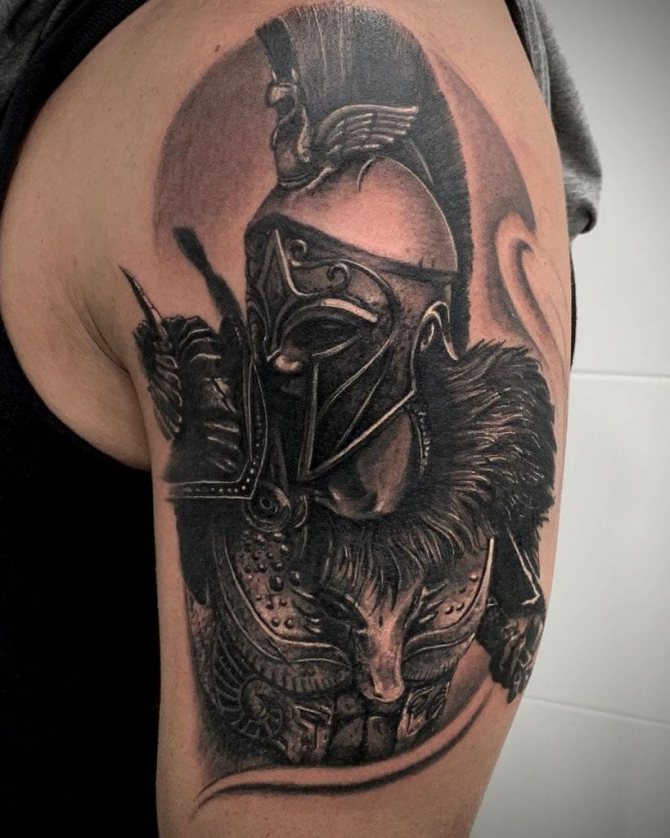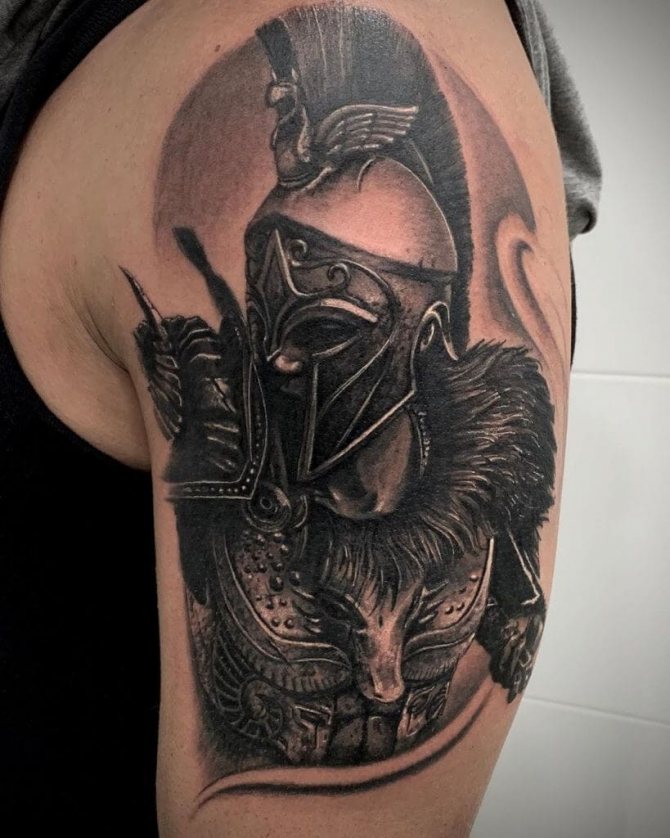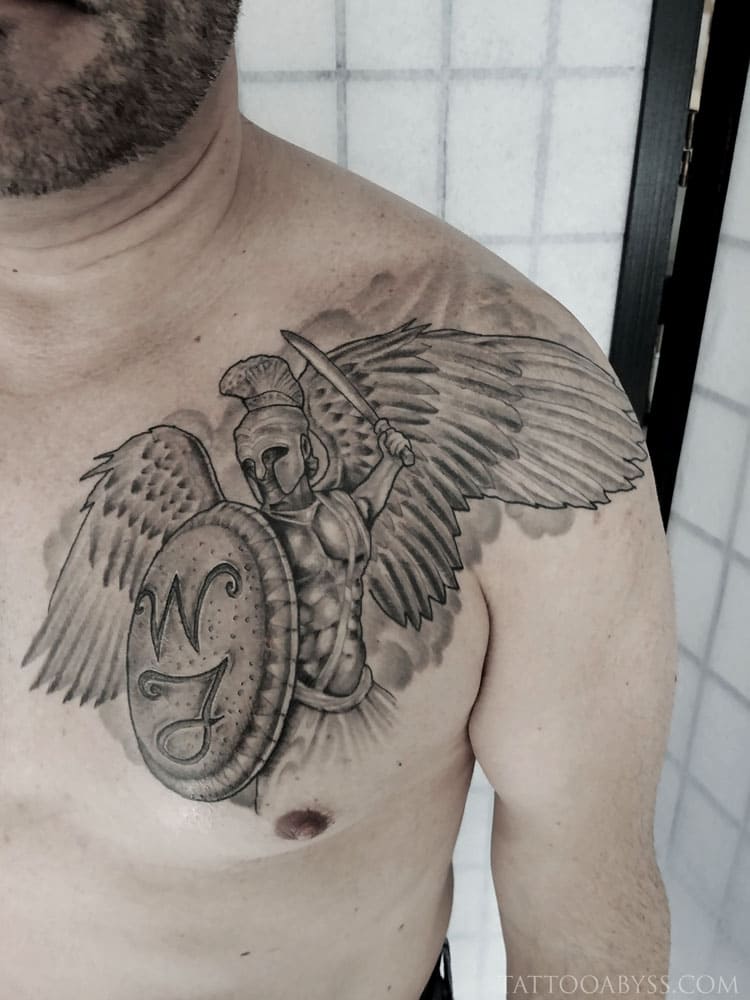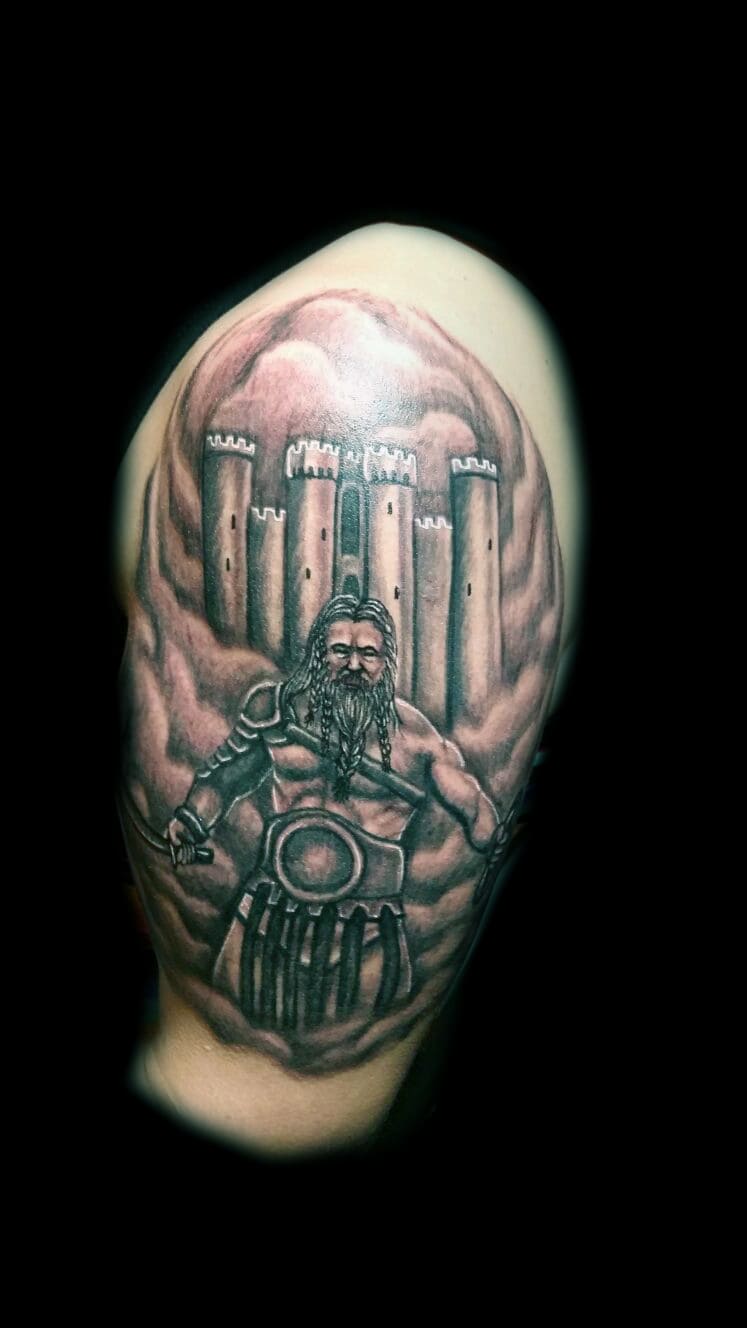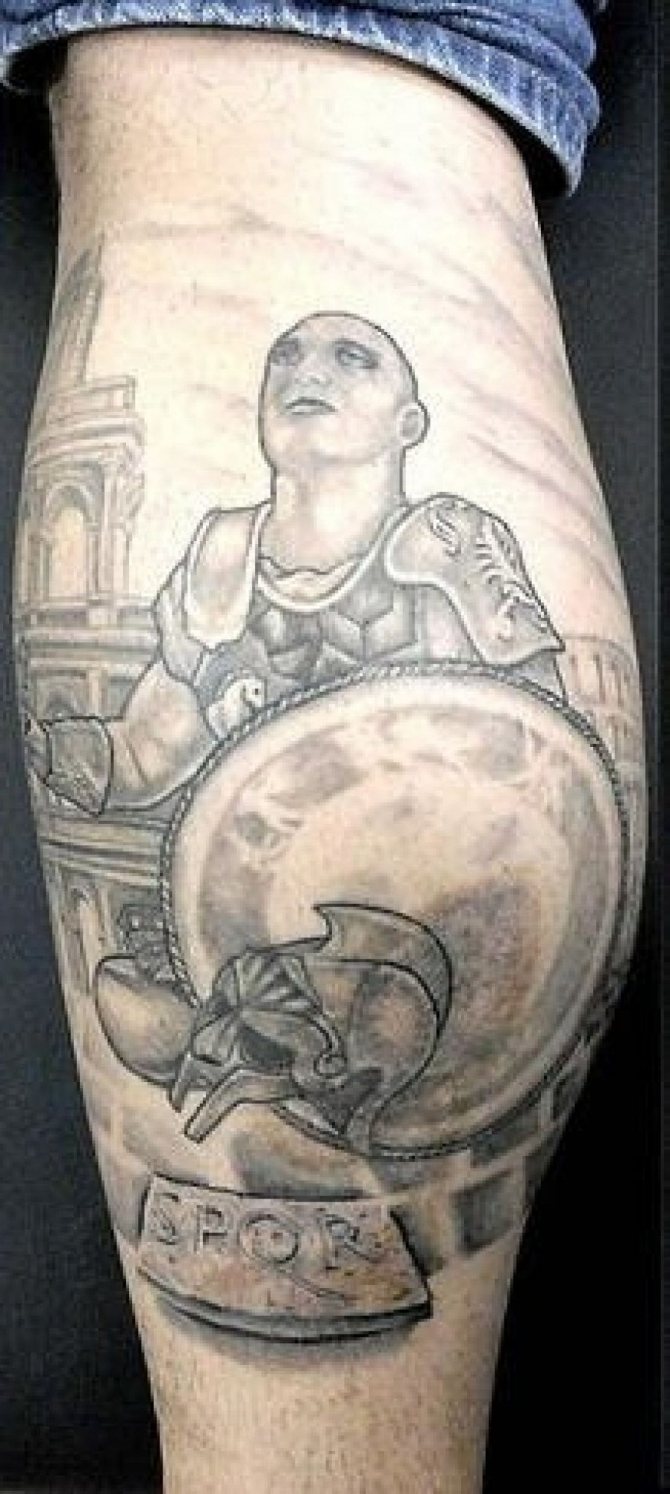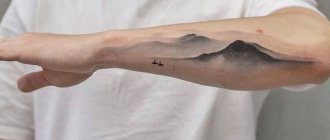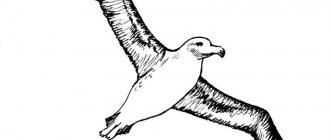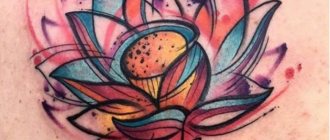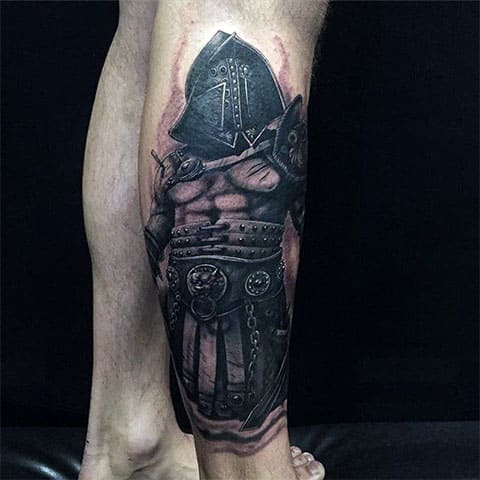
Tattoo gladiator
Before you do gladiator tattooBe sure to learn about its meaning. The word "gladiator" comes from the Latin "gladius", which translates as a sword. In those ancient times it was customary to call gladiators unwilling people, slaves, or soldiers taken prisoner during battles, as well as criminals.
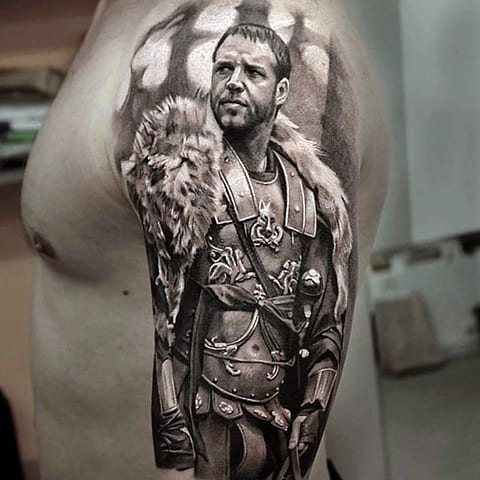

Tattoo of a gladiator from a movie
Tattoo of the eyes of a gladiator.
All of them were previously taught how to properly handle a sword. Once the gladiators had acquired the necessary skills, they were pitted against each other. Such battles ended in the death of one of them. Bloody battles in ancient Rome were held in arenas for seven hundred years.
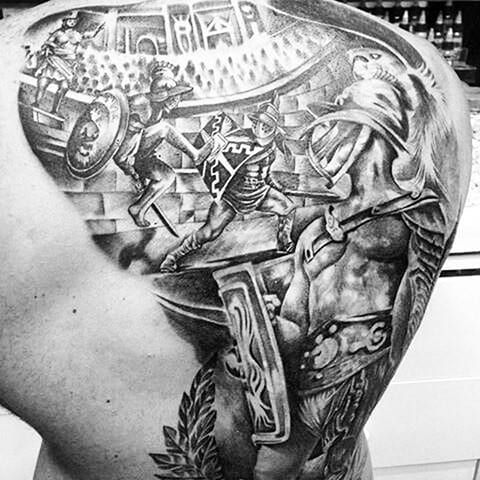

Tattoo of a gladiator on his back
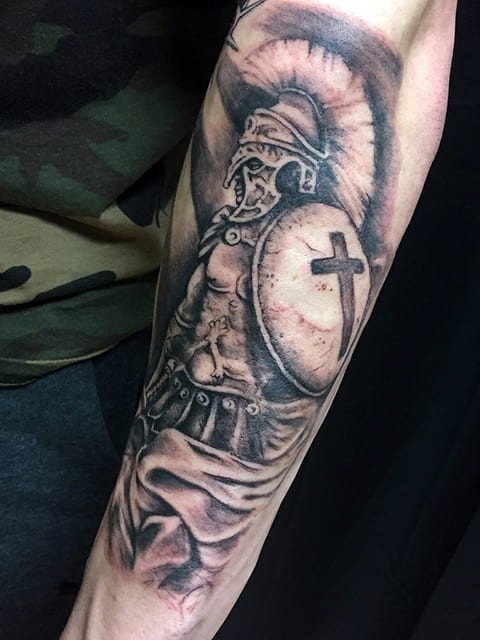

Tattoo with a gladiator
In the beginning, the Romans preferred to arrange such fights on feast days. They wanted to thus satisfy the cruel god of war Mars. Over time, such battles began to be held for entertainment without any particular occasion. The Roman sacrifices in the form of gladiatorial fights were borrowed from the Egyptians, the Etruscans, and the Greeks. This is easily explained by the fact that throughout the Empire lived different peoples, which either conquered or they joined of their own accord.
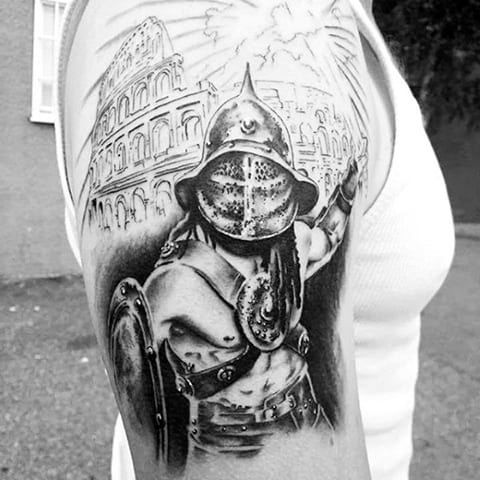

Tattoo of a gladiator on the shoulder
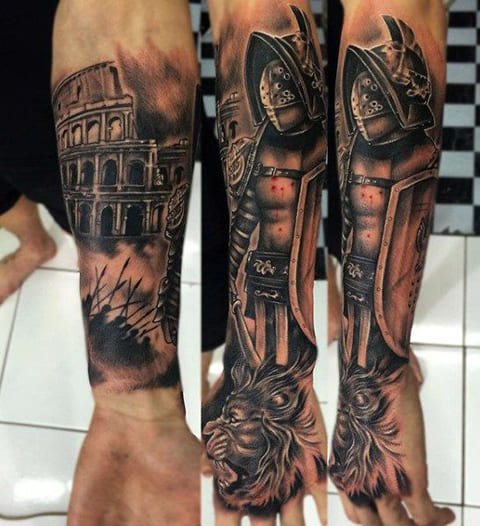

Tattoo of a gladiator on the arm
Initially, gladiators became prisoners of war, as well as all those who were sentenced to death. There was a law according to which a fighter who defeated all opponents not only won a considerable sum of money. He had the right to buy his own life. Sometimes people in the pursuit of big money on their own will became gladiators.


Tattoo gladiator on the shoulder and chest
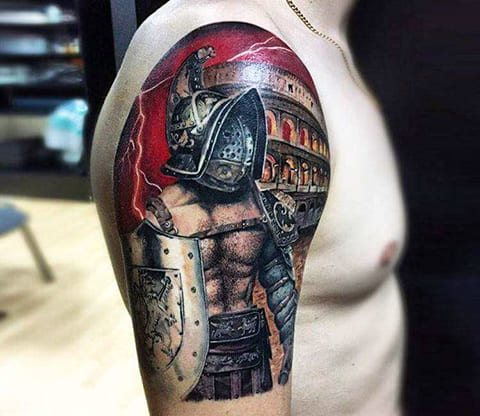

Tattoo gladiator
It was customary to divide all slaves into types. And from this depended on what weapons will have, will have to fight on horseback or on foot, with animals, people or just to show numbers with animals. Even women could take part in such fights. Later it was possible to fight and dwarves.
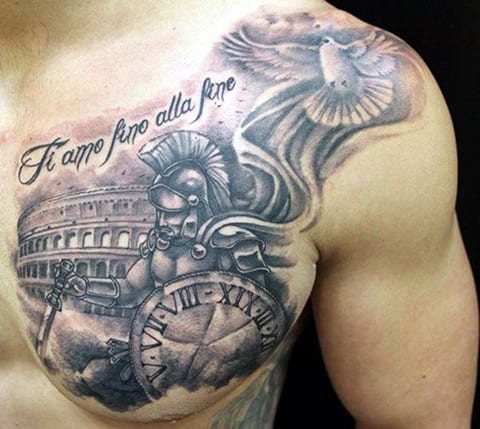

Tattoo gladiator
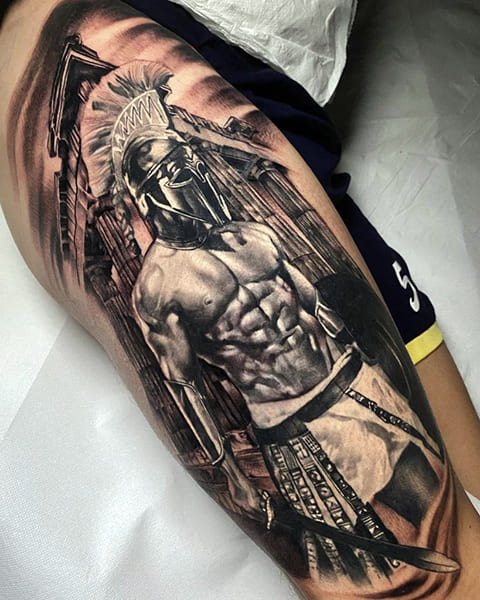

Tattoo gladiator on the hip
Officially banned gladiatorial fights in 404, when the Emperor Honorius came to power. At that time there was already a Christian religion and the audience resented everything that was happening in the arena. After the decree was introduced, gladiatorial fights continued, but all participants remained alive. In those days there was a special school where they taught to fight and prepared to fight for money. After the collapse of the Empire gladiatorial battles were no longer held.
The Cultural and Historical Heritage of Ancient Rome
Inspiring and presented in a huge variety of photos are tattoos in the Roman style. Conquerors of the world and conquerors of many barbarian tribes, the Romans were distinguished by an advanced outlook on life, for them the highest value was considered the freedom of the individual, power and wise philosophy.


Regardless of the significance of the chosen tattoo, it can be applied to both men and women. Choosing the original sketch, you can consult with a master and he will help you to pick up additional elements or design style that will more accurately match the semantic content.
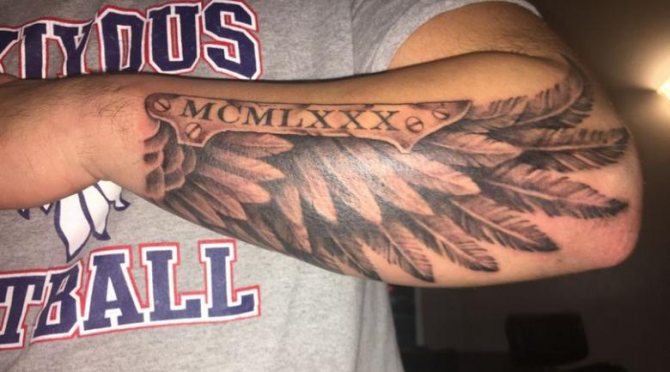

Roman numerals, how to choose your own tattoo
Latin numbers can denote a date, a quantity, or encode whole concepts. If you figure it out, you have an endless number of options for tattoos.
Creating an original image will take several hours. For onlookers, it will adorn your skin and for you, it will carry a secret message.
To pick up your tattoo Roman numbers should carry a meaning for you personally. You can encode your date of birth in the drawing. You can record a unique event that influenced your life.
The best method to decide is to find an experienced master working in the style of lettering. He will help to determine the place for the application, and develop a design for you numbers. In the end you will have an original tattoo that carries meaning and acts as a decoration.
What are the Roman style tattoos and their interesting options
The development of Roman culture was facilitated by the military, science and religion, so the meanings of the drawings on the body can be different. More often among the images for tattoos in the Roman style choose a few general directions with original additions to the composition:
- Roman numerals, it can be a memorable date, his own birthday or the memory of other memorable events in the life of a person;
- warrior(s) or military equipment, such tattoos symbolize courage and bravery, bordering on recklessness, valor and the ability to stand up for their honor;
- The gods of the Roman pantheon, Jupiter and Juno, Neptune and Ceres, Titans and Cyclopes, can be the main characters in tattoos with different subjects.
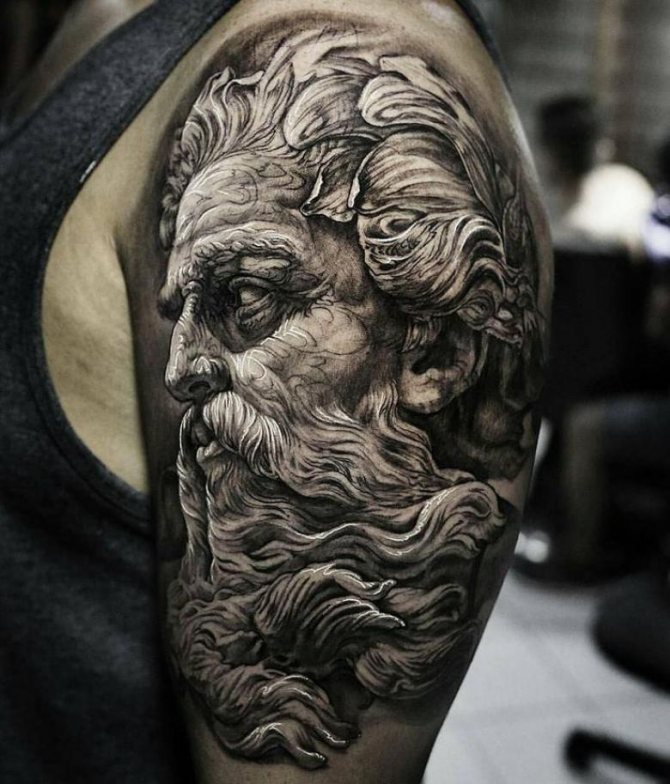

A special category of tattoos are symbolic images with additions of inscriptions and winged sayings. Many quotes from Roman philosophers are easily recognizable and are a ready template to add to a body image or a beautiful picture that carries a certain meaning.
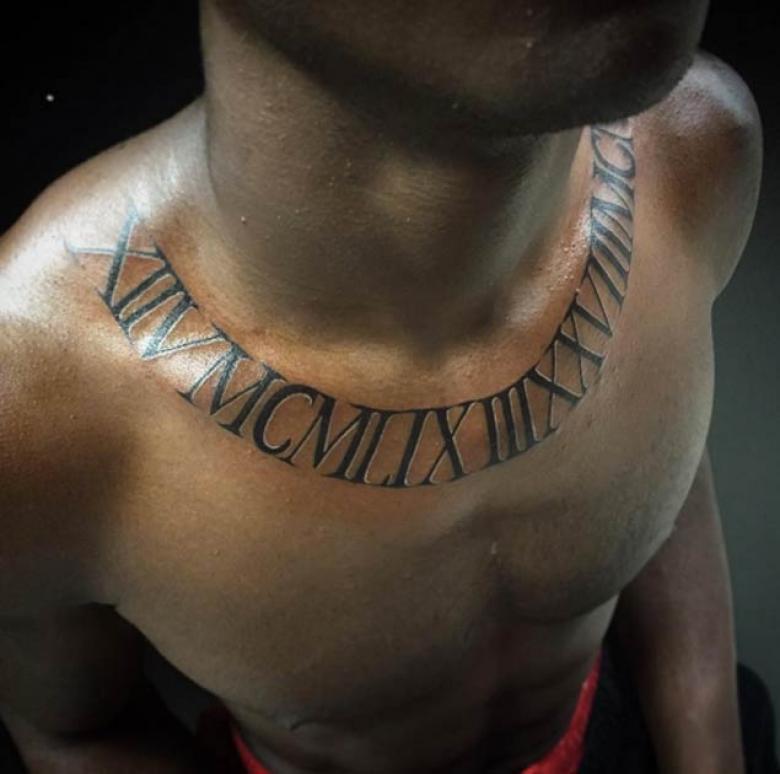

This is interesting: The tradition of tattoos in the Roman army included the mandatory application of symbols to soldiers to signify their assignment to a particular unit or army. Today, many servicemen return from military or contract service with similar, albeit stylized images.


Sailor tattoos
What a sailor without a tattoo - at least an anchor for decency should hang! And for beauty - the silhouette of a beloved girl, saving from loneliness during a long voyage.
It is believed that the tradition of maritime tattoos began after James Cook's voyage to Oceania. Maori tattoos are beautiful in their own right, but superstitious sailors did not put them on just for beauty's sake, quickly believing they brought good luck. By the early twentieth century, maritime tattoos were as much a sign of the trade as bodysuits, snorkels and brothel-hopping. True, the leadership did not welcome Papuan-like sailors in Her Majesty's service. As a result, everything was permitted except tattoos above the neck and below the knee, as well as obscene words and drawings. Nevertheless, each picture had some meaning and carried specific information about its owner. Or was a talisman. Since English sailors were everywhere, the fashion to draw patterns on the body was infected by sailors of other states. Although the same Russian, Dutch and French sailors who actively sailed in Oceania (Papua New Guinea almost became a Russian colony) picked up the habit without intermediaries.
As has been said, all sorts of things were stuffed. The most popular were a pig and a rooster, which were prescribed on the legs. These two animals were supposed to help the sailor survive the wreck: Neither the pig nor the hen could swim, so God would help them. The reason, though, is that they were very often saved because they were carried in wooden crates that held up perfectly to the water. The anchor originally symbolized sailing on the Atlantic - a little later it began to be pounded by bosuns. Nowadays, the anchor is being pounded by everyone. The crossed anchors, on the other hand, are a different story. It is also made by bosuns and either those who have visited all the oceans (placed on the left hand) or those who have visited the 7 seas (on the right). Everything is clear with the compass: the guiding star, which will not let you lose your way. But what do the swallows mean? Nothing delicate - they are given to the tough men who have covered 5000 nautical miles (9260 kilometers). It was only a while later the brutal romanticism of sea wolves infected the land rats and sea tattoos have migrated to ordinary life, giving courage to those who have the same attitude to the sea as the rapper Feduk with his song "Sailor".
Basic motifs and original solutions for Roman tattoos
Before applying a tattoo, a good master from the salon will always help pick up a drawing or give sound advice. When carefully selecting a pattern, you can be guided by the general direction of the images, which will become a beautiful decoration of the body and will carry its mysterious meaning:
- The battle between the warrior and the monster. In Roman mythology, there are many gods borrowed from the Hellenes, but many own monsters with which to fight the heroes. Such tattoos often symbolize the victory over himself and his own shortcomings, over the difficulties of life and circumstances;
- commemorative dates with Roman numerals. Elegant and originally designed Roman numerals are not easy to read for those who are more accustomed to Arabic numerals. But it is precisely such inscriptions that attract the most attention and can be the date of birth or wedding, mark a turning point in a person's fate;
- laurel wreath. Such tattoos can mean equating oneself with a winner, and the victory can be over oneself or over others. The laurel wreath to the victor was traditionally awarded in Hellenic culture, but not without reason many Roman emperors were crowned with this attribute of power and involvement in the royal dynasty.
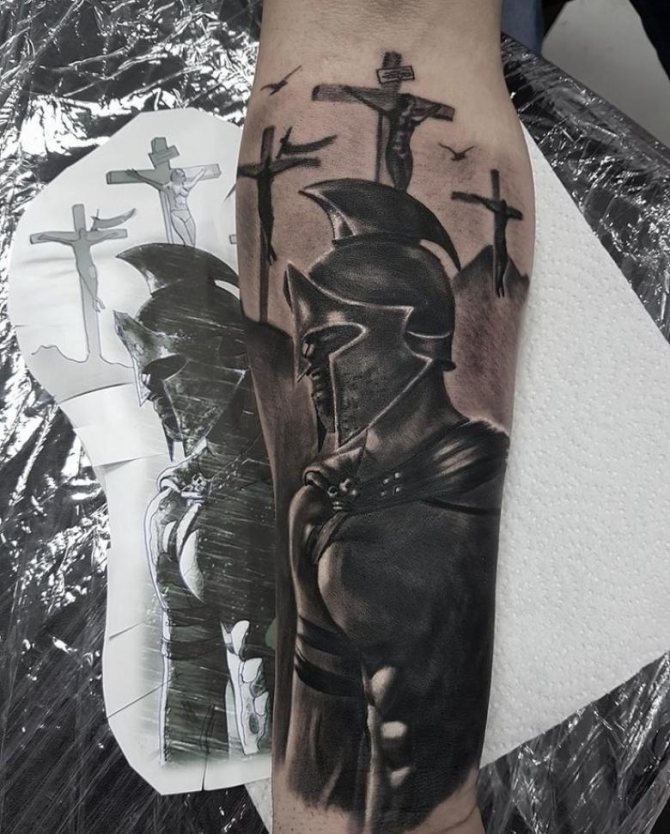

Often, for a natal image chosen figure and symbolic images of Fortune, the goddess of good luck. These tattoos do not necessarily have to adorn the body of players, they are chosen by those who felt an unexpected pleasant turn of fate, overcome obstacles or who really smiled on good luck.


Types of gladiator tattoos
Before you go to a tattoo studio, it is important to decide on a sketch. Today there are many options for a gladiator tattoo. So it can be a tattoo of a gladiator Spartacus, as well as with armor and helmet. No less interesting variant of a body drawing is the Colosseum of a gladiator.
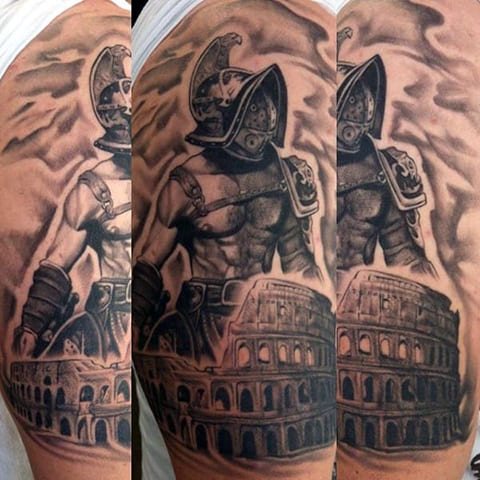

Tattoo gladiator
As the tattoo is accepted to do in a realistic style, try to find a good master. Here everything will be important: the pose, facial expressions, weapons, gestures.
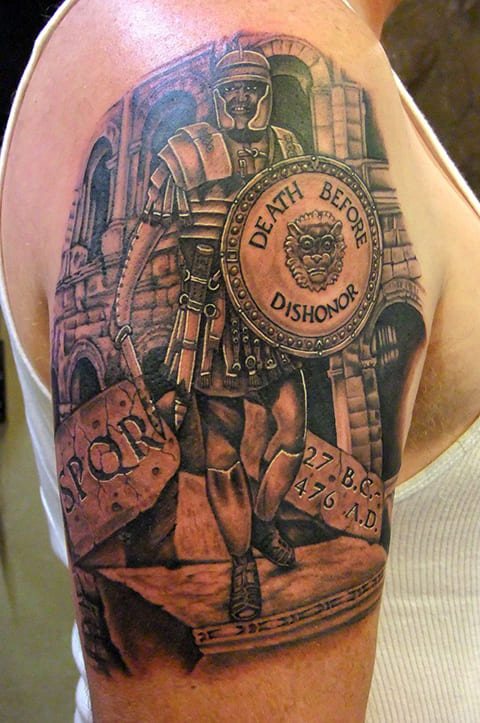

Tattoo gladiator
If you wish it is possible to make a tattoo with a face of the Roman slave or in full growth. As an option, you can make a plot tattoo. The body image can be both colored and in black and white.
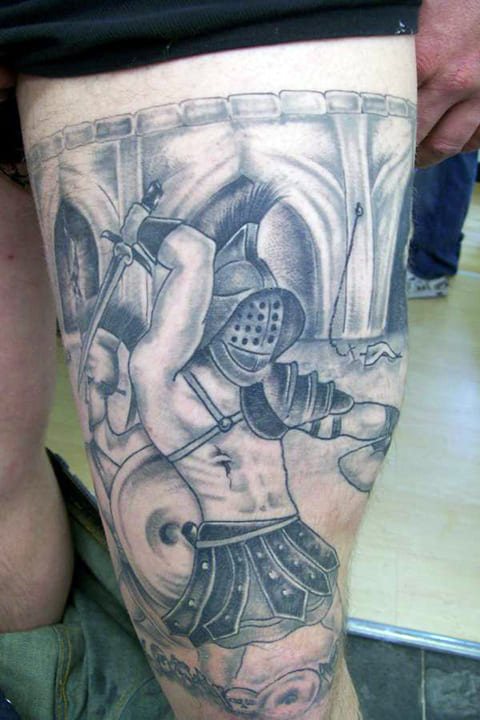

Tattoo gladiator with a sword
Especially spectacular tattoo with the image of a gladiator will look along the entire length of the back, on the arm, stomach and leg. Much will depend on the chosen sketch.
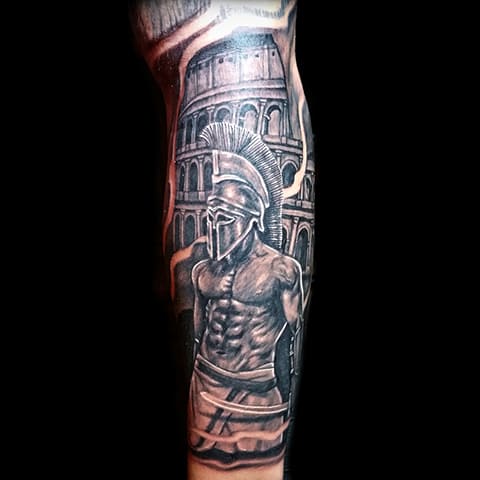

Tattoo with a gladiator
Plot tattoo gladiator battle is best done on a larger area - the back or the stomach. Tattoo with helmet and armor are often made on the arm, leg and shoulder.
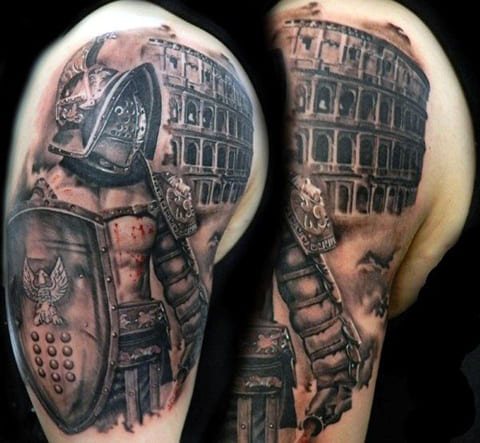

Tattoo with a gladiator on the shoulder
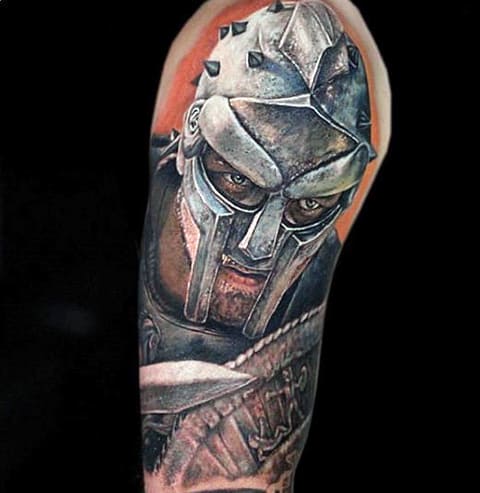

Tattoo gladiator - photo
You can get tattoos of Roman gladiators in a salon. As a sketch, you can use not only fan art from the Internet, but even frames from movies, although we recommend not to plagiarize and turn to professionals who will draw an individual sketch for you. By the way, just below you will find a link to the largest studio that deals with sketches.
Winged expressions and phrases in Latin as tattoos
Latin is quite an ancient language and although it is now more familiar to medics, winged quotes in it remain popular. Philosophical sayings have not lost their relevance in today's world, and in order to pick one that fits the meaning you can explore a whole collection of popular Latin expressions, for example:
- A potentia ad actum (from desire to reality);
- Hic sunt leones (lions live here);
- Lux in tenebris (a ray of light in the dark);
- Utile dulce miscere (both pleasant and useful);
- Contra spem spero (hope without hope);
- Nec sutor ultra crepidam (one cannot judge what one does not know);
- Omnes vulnerant, ultima necat (with every hour we are weaker and the last minute kills us);
- Quis custodiet ipsos custodes? (who keeps watch over the watchmen themselves?);
- Casus a NULLo praestantur (man is powerless against chance);
- Cui podest malum? (who benefits from it);
- Ex mero motu (without compulsion);
- Don gratuit (brought voluntarily as a gift);
- Dum vivimus vivamus (we all live as long as we live).


Another interesting and original solution for a tattoo in the Roman style are abbreviations of several letters. Latin capitals with dots can mean the name of a loved one, but most often they are abbreviated winged phrases, the meaning of which is known only to the tattoo owner and his closest friends.
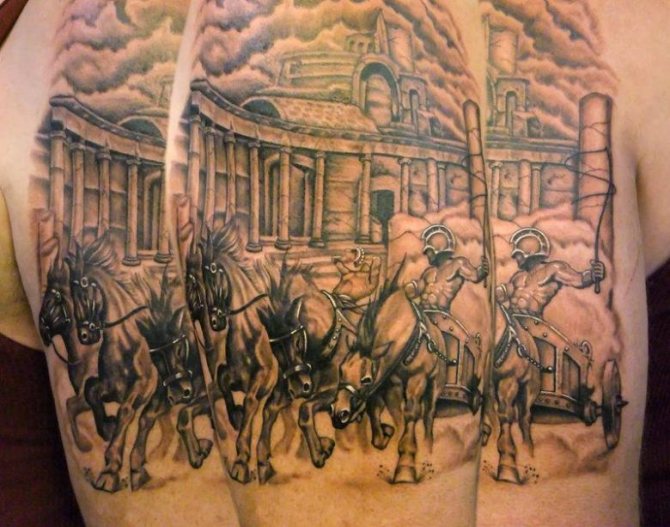

Original tattoos in the Roman style or with Latin phrases will help to inspire true connoisseurs of the classics before you apply the image it is better to know in advance the exact meaning of the sketch, especially if it is a winged expression and this information will help to determine the choice. Together with the wizard you can choose the original font, size and slant of the letters, emphasizing your own individual style and complementing the bright and exclusive image.
Tattoo gladiator: history
As already mentioned, a gladiator is a bonded warrior, participating in bloody confrontations. This type of fighting first appeared in Ancient Rome and was held in special arenas with spectators for seven centuries. At first, the Romans held these events, performances only during feasts, so that a gladiator who died in battle served as a religious sacrifice to Mars, who was considered the bloodthirsty god of war. Later, gladiatorial duels were so beloved by the locals that they began to be held as revelry on any occasion.


The Romans adopted the sacrifice to a god from the Greeks, Etruscans, and Egyptians. The reason for the creation of such duels was the sheer number of inhabitants conquered by force or voluntarily annexed to the vast Roman Empire. Originally, only prisoners and criminals who were sentenced to death could become gladiators. There was also a law according to which a victorious gladiator could accumulate a lot of money and redeem his life. There were also known cases where ordinary and free people who wanted to earn money went to the fights.
All gladiators were divided into several categories, depending on the quantity and quality of ammunition, weapons, and aids. There were also gladiators on foot and those who fought on horseback. The battle could be fought against a man or an animal. Categories of gladiators:
- Andabats.
- Pregenarii.
- Venators.
- Tertiaries.
- Murmillons.
- Provocateurs.
- Samnites.
- Dimacherians.
- Gauls.
- Retiarii and others.
In order to become a gladiator one had to recognize oneself as "legally dead" and take an oath, after which one entered a world of other concepts and laws. The ideological basis of duels was the sacrifice of the living in order to feed the dead. It is worth noting that to become a gladiator in the future could not only men, but also girls, as well as dwarves.
In 404 Emperor Honorius established an official ban on gladiatorial fights, as Christianity resented such an action. The reason for the decision was the death of a monk who was killed by the public, because he tried to stop the fight by running out into the arena. After that the fights were purely entertaining, almost all the fighters stayed alive and earned money that way. In case of war, gladiators were the first people drafted into the army. It was only after the collapse of the Roman Empire that gladiators and their confrontations finally ceased to exist.
Technique of execution and a choice of a place on a body
A picture of the gladiator tattoo Will look spectacular when the basis is taken in the style of realism. The clearer the details are traced, the better. However, depending on the tasks, other styles are also allowed:
- Thresh-polka is chosen to emphasize the militant spirit;
- Tattoo gladiator on the arm, made in the technique of graphics, looks more dynamic, bright, but not as aggressive looking tattoo in the style of watercolor;
- If you intend to do a small monochrome painting, you should pay attention to the dotwork style.
Fragments of battle look great in a large-scale painting on the back or chest. The armor or bust of a gladiator is more often depicted on the forearm. Tattoo sleeve is used to draw a life-size drawing of a warrior's armor.


